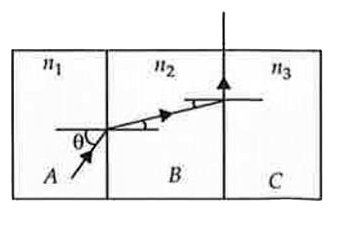A spherical surface of radius 30 cm separates two transparent media A and B with refractive indices 1'33 and 1.48 respectively. The medium A is on the convex side of the surface. Where should a point object be placed in medium A so that the paraxial rays become parallel after refraction at the surface ?Solution in Gujrati
The correct Answer is:A, B, C
μ2v−μ1u=μ2−μ1R
−1.33u=0.1530×100

u=20×0.35100=−266cm
Topper's Solved these Questions
Similar Questions
If the light moving in a straight line bends by a small but fixed angle it may be a case of
View SolutionThe electric field in a region is given by →E=35E0→i+45E0→j with E0=2.0×103NC−1. Find the flux of this field through a recatngular surface of area 0.2m2 parallel to the y-z plane.
View SolutionFind the range of frequency of light that is visible to an average human being (400nm<λ<700nm)
View SolutionA spherical surface of radius 30 cm separates two transparent media A and B with refractive indices 1'33 and 1.48 respectively. The medium A is on the convex side of the surface. Where should a point object be placed in medium A so that the paraxial rays become parallel after refraction at the surface ?
View SolutionA spherical surface of radius 30cm separates two transparent media A and B with refractive indiecs 1.33 and 1.48 , respectively. The medium A is on the convex side of the surface. Where should a point object the placed in medium A so that the paraxial rays become parallel after refraction at the surface?
View SolutionDiscuss refraction from denser to rerer medium at a convex spherical refracting surface.
View SolutionA convex refracting surface of radius of curvature 20cm separates two media of refractive indices 4/3and1.60. An object is placed in the first medium (μ=4/3) at a distance of 200cm from the refracting surface. Calculate the position of image formed.
View SolutionProceeding from Fermat'sprinciple derive the refraction formula for paraxial rays on a spherical boundary surface of radius R between media with refractive indices n and n'.
View SolutionA spherical surface S separates two media 1 and 2 as shown in figure .Find where an object O is placed in medium -I so that the light rays from object after refraction becomes parallel to optic of this system

240 cm
View SolutionParallel rays of light are falling on convex sphere surface of radius of curvature R = 20 cm as show. Refractive index of the medium is μ=1.5. A refraction from the spherical surface parallel rays

View Solutionn1 तथा n2 अपवर्तनांक के दो माध्यमों को अलग करने वाले उत्तल गोलीय पृष्ट के लिये अपवर्तन सम्बन्धी सूत्र स्थापित कीजिए |
View SolutionA concave spherical surface of radius of curvature 100 cm separates two media of refractive indices 1.50 and 43. An object is kept in the first medium at a distance of 30 cm from the surface. Calculate the position of the image.
View SolutionA convex surface of radius of curvature 40 cm separate two media of refractive indices 43 and 1.50. An object is kept in the first medium at a distance of 20 cm from the surface. Calculate the position of the image.
View Solutionदो माध्यमों A तथा B के बीच की सतह गोलाकार हैं जिसकी त्रिज्या 30 cm हैं । माध्यम A का अपवर्तनांक 1.33 तथा B का अपवर्तनांक 1.48 हैं । माध्यम A से देखने पर यह सतह उत्तल दिखती हैं । माध्यम A में एक बिंदुस्त्रोत को सतह से कितनी दूर पर रखा जाए कि इससे चलती उपाक्षीय किरणें अपवर्तन के बाद समानांतर हो जाएँ ?
View SolutionA,B and C are the parallel sided transparent media of refractive index n1,n2 and n3 respectively.
The are arranged as shown in the figure. A ray is incident at an angle θ on the surface of separation of A and B which is as shown in the figure. After the refraction into the medium B, the ray grazes the surface of separation of the media B and C. Then, sinθ=
View Solutionप्रकाश की समान्तर किरणें वक्रता त्रिज्या R = 20 सेमी उत्तल सतह पर आपतित होती हैं। इसके माध्यम का अपवर्तनांक μ=1.5 है। गोलीय सतह से परावर्तन के बाद समान्तर किरणें

View Solution
